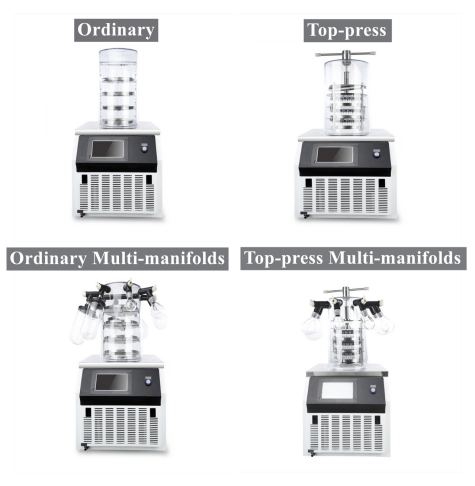Currently, freeze-drying technology is extensively utilized in various fields such as medicine, biological products, food, active substances, and nanomaterials. Laboratory freeze dryers play a vital role in research and development, testing applications in academic institutions, corporate laboratories, experimental scientific research in industries like bio-cosmetics and pharmaceuticals, as well as experimental research and development in the food and medicinal materials industries, nanomaterials, chemical materials, and other industrial scientific research applications.

In laboratory settings, the equipment often required is known as a Laboratory Freeze Dryer. Its primary function is to aid in the restoration of the conformation and biological function of bioactive substances before freeze-drying after redissolving. So, what exactly is a freeze dryer and what are its characteristics?
A Laboratory Freeze Dryer operates on the principle of freeze drying, also referred to as drying, sublimation drying, or freeze-drying for short. It is a drying method employed for the purpose of preserving items.
The degradation, spoilage, and deterioration of items are primarily caused by two factors: external and internal factors. External factors encompass the effects of air, water, temperature, and biological elements. By minimizing the impact of external and internal factors, it becomes possible to achieve the objective of preserving items unaltered for a certain period.
The drying process involves the removal of moisture contained within the item, as moisture is a necessary condition for the growth of all living organisms. When the water content of an organism is sufficiently reduced, its ability to grow and reproduce becomes hindered or even impossible. This enables the item to be stored for extended periods. Additionally, the presence of water can lead to the dissolution of certain acids and alkalis, resulting in chemical reactions that cause the deterioration of goods.
Key features of laboratory freeze dryers include:
Ordinary Type: Used for a wide range of materials, these freeze dryers allow the materials to be directly placed into the material tray for freeze-drying.
Gland Type: This type is suitable when the material needs to be dried within a vial, and it should not be exposed to the outside air after drying. The vial is sealed under a vacuum after the drying process is complete.
Multi-Manifold Type: When drying multiple varieties of materials simultaneously without them affecting or intersecting each other, the multi-manifold type is required. It facilitates observation and temporary sampling.
Multi-Manifold Gland Type: This type is chosen when there are various materials that need to be dried, and some require processing in vials, while others require different methods.
Small In-Situ Pre-Freeze Type: This type enables in-situ pre-freeze drying, with features such as one-button start, adjustable temperature, controllable production process, program operation prompt function, and automatic control of the entire freeze-drying process. It offers the option to select program mode or vacuum mode.
Before utilizing a freeze dryer, several preparations should be made:
Verify the normal power supply voltage for the freeze dryer.
Ensure the accurate placement of the temperature measurement camera within the freeze-drying chamber.
Check the mechanical pump's vacuum pump oil in the freeze dryer. It should be clear and not too thick, and the oil quantity should correspond with the oil mirror.
Inspect the gate valve components in the ultrafiltration device to ensure they meet the normal working standards. Close all gate valves leading to the air.
Ensure the defrosting water in the cold trap has been drained completely.
Maintenance of a laboratory freeze dryer is crucial and must adhere to specific requirements, particularly regarding the inspection and replacement of lubricating grease. The replacement cycle of lubricating oil in a laboratory freeze dryer is influenced by the temperature at the compression end. When the temperature at the compression end is high, the lubricating oil should be replaced more frequently.
Generally, lubricating oil should be checked every 10,000 hours of continuous operation. When the compressor is initially operated, it is recommended to change the lubricating oil and clean the oil filter after 2,000 hours of operation. If the system is operating properly, the lubricating oil should be changed every 20,000 hours. When inspecting and replacing the lubricating oil, it is important to avoid prolonged exposure to air due to the freezer's water absorption.
In the event of a laboratory freeze dryer failure, a thorough investigation of the cause is necessary. If needed, it is advisable to seek assistance from a professional company to identify and rectify the issue.
If the motor of the laboratory freeze dryer burns out, impurities such as patent skin can spread throughout the refrigeration system. During maintenance, the entire system's filtration system should be thoroughly inspected and replaced if necessary. Improper handling in this regard can have detrimental effects on the compressor's long-term operation, and even lead to irreversible consequences due to minor losses.
After overhauling the compressor, the system should be dehumidified. It is recommended to pass dry nitrogen through the system for drying, followed by vacuum treatment. The lower the vacuum level, the more advantageous it is for subsequent system operation, as it increases efficiency. Testing for leaks and maintaining pressure should be taken seriously, as most refrigeration system failures stem from leaks in the system.







Comments (0)